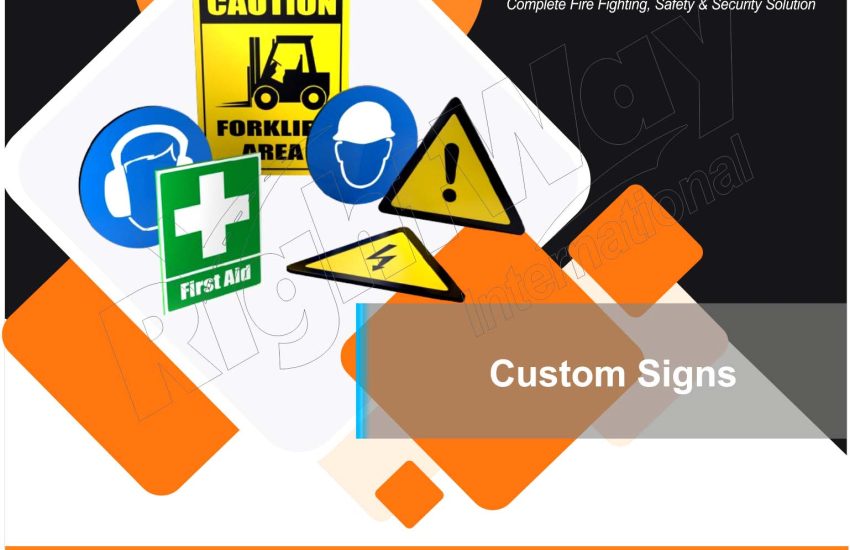Safety Custom Signs are a critical component of maintaining a safe environment in various settings, including workplaces, public spaces, and private properties. These signs are tailored to address specific hazards, provide essential safety information, and ensure compliance with regulations. This article explores the significance of safety custom signs, their types, design considerations, and best practices for implementation and maintenance.
Importance of Safety Custom Signs
Safety custom signs are vital for several reasons:
- Hazard Communication: They effectively communicate specific hazards and safety protocols, helping to prevent accidents and injuries by informing individuals of potential dangers and necessary precautions.
- Compliance: Custom safety signs ensure adherence to local, state, and national regulations, such as OSHA (Occupational Safety and Health Administration) standards, and industry-specific requirements.
- Enhanced Awareness: By providing clear and tailored information, custom safety signs increase awareness of safety procedures and emergency response actions, contributing to a safer environment.
- Customized Solutions: Custom signs allow organizations to address unique hazards and safety needs specific to their environment, improving the relevance and effectiveness of the signage.
Types of Safety Custom Signs
- Warning Signs: These signs alert individuals to potential hazards that could cause injury or damage, such as “Caution: Wet Floor” or “Danger: High Voltage.” They often use bold colors and symbols to grab attention.
- Mandatory Signs: These signs indicate required actions or behaviors, such as “Wear Protective Gear” or “Keep Fire Exits Clear.” They use blue or green colors to denote mandatory requirements.
- Prohibition Signs: These signs communicate actions that are not allowed, such as “No Smoking” or “Do Not Enter.” They are typically marked with red and white to indicate restrictions.
- Emergency Signs: Custom signs that provide information on emergency exits, first aid stations, or evacuation routes, such as “Emergency Exit” or “First Aid Kit Location.”
- Informational Signs: These signs offer general safety information or instructions, like “Safe Work Area” or “Hazardous Material Storage.” They are designed to inform and guide users effectively.
Design Considerations
Effective safety custom signs require careful attention to several design factors:
- Clarity: Use clear, concise language and easily recognizable symbols to convey the intended message. Avoid complex terminology that might confuse readers.
- Visibility: Ensure that signs are visible from a distance and in various lighting conditions. High-contrast colors, such as black text on a yellow background, enhance readability.
- Legibility: Choose legible fonts and text sizes that can be easily read from different distances. Sans-serif fonts are often preferred for their clarity.
- Material and Durability: Select materials that are suitable for the environment, such as weather-resistant or fire-retardant materials for outdoor or hazardous areas.
- Compliance: Ensure that custom safety signs meet relevant safety standards and regulations, such as those set by OSHA, ANSI (American National Standards Institute), or local building codes.
Best Practices for Implementation and Maintenance
- Strategic Placement: Position safety signs in locations where they will be most effective, such as near potential hazards, high-traffic areas, or key decision points. Ensure they are at eye level and not obstructed.
- Regular Inspections: Conduct routine inspections to check for signs of damage, fading, or obstructions. Replace or repair signs as needed to maintain their effectiveness.
- Training and Awareness: Educate employees and individuals about the significance of safety signs and how to respond to them. Regular safety training and drills can reinforce the importance of following sign instructions.
- Customization: Tailor safety signs to address specific hazards and needs of your environment. Customization ensures that the signs are relevant and provide clear guidance based on the unique safety requirements.
- Documentation and Compliance: Keep records of safety sign installations and updates. Regularly review and update signs to comply with any changes in regulations or safety procedures.
Conclusion
Safety custom signs play a crucial role in hazard communication and creating a safe environment. By providing clear, tailored information and adhering to best design practices, these signs help prevent accidents, ensure compliance, and enhance overall safety. Regular maintenance and strategic placement further ensure that safety signs remain effective and continue to contribute to a safer environment for everyone.


